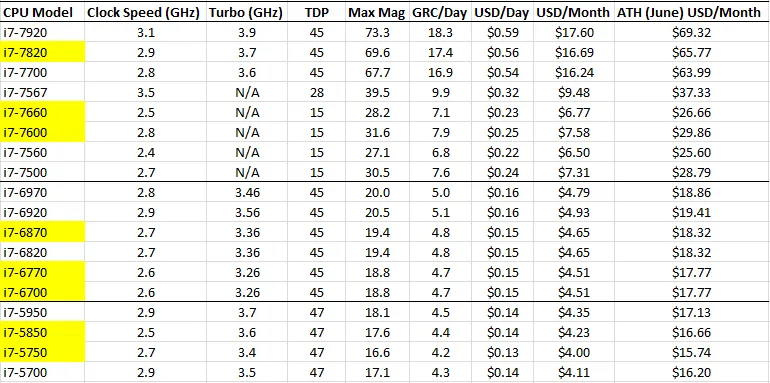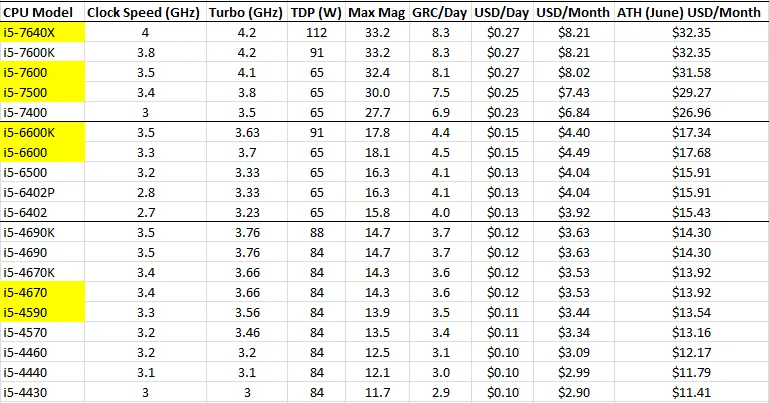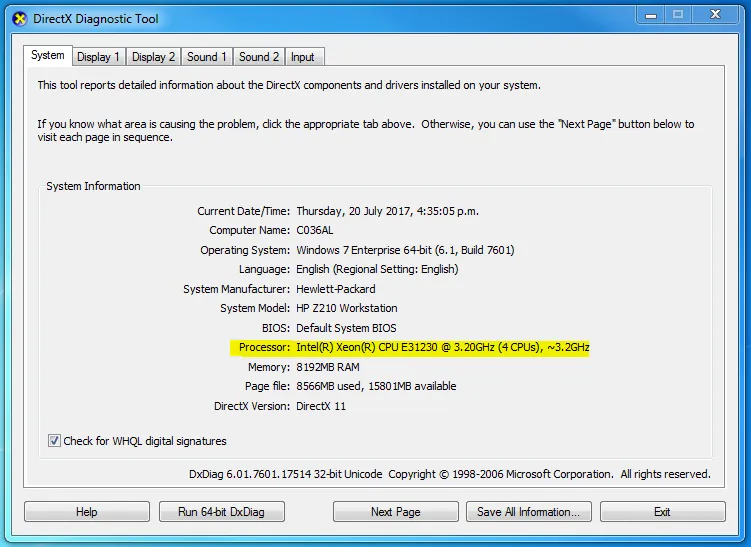
One of the most significant benefits of 'mining' Gridcoin is that it can still be done very profitably on a CPU - something that other coins have left far behind them. The reason for this is that unlike traditional POW mining used by coins such as Bitcoin, Gridcoin 'mining' is done by contributing compute to scientific endeavours through the BOINC platform. Science computations are fickle beasts, ranging from the most simple calculation to colossal complexity which only a CPU can manage. As a result, many BOINC projects that reward compute with through Gridcoin are not able to make use of a GPU, and no BOINC projects at all can make use of ASICS.
Unfortunately, benchmarking CPU performance is not as easy as GPU performance. We cannot just compare the number of logical cores and clock speeds. This might seem counter intuitive, as wouldn't it make sense that the faster the clock speed and the more cores on the CPU, the more work we can do with it? The answer lies somewhere between a 'yes' and a 'no'...
We can successfully use the two metrics above to make comparisons within an architecture family. If we compare two Intel Haswell i7 cores, the one with the higher clock speed will outperform the slower one. This is the case because other than clock speed, the processors are architecturally identical. However, comparing between series gets more complex.
Would you believe me if I told you that Intel released the first 3.6 GHz chips way back in 2006? Well, it's true. Even though over a decade has passed, the fastest Intel cores run at factory speeds of about 4.4 GHz, which seems like a very marginal improvement. As a matter of fact, most actual headway was made in the amount of work done by the CPU in each individual clock cycle, not in the number of cycles per second. There are other factors that influence processing speed too, such as improvements in cache memory, but the work done per clock cycle is by far the most significant gain realised.
Before getting into the details of the various CPU models, lets quickly review Gridcoin mining. Just like mining other crypto, with Gridcoin:
- The amount you earn depends on how much you contribute to the network compute relative to everyone else.
- You can join a pool to get paid more steadily, rather than having to get lucky staking a block.
- More powerful hardware outcompetes less powerful hardware generally speaking.
However, unlike mining other crypto, with Gridcoin:
- Your compute power is used to solve research problems, primarily for the scientific community. These problems are complex, and vary wildly between projects that the Gridcoin Network rewards contributions on. As a result, hardware performance will vary between projects, as will your mining rate.
- Hashing power is meaningless, so hardware profitability cannot be readily compared
- The daily Gridcoin mint is spread across the 'whitelisted projects', which are projects eligible for rewards (you run these projects - you get paid GRC). If the number of projects in the whitelist changes, this will significantly impact your daily GRC mint.
The best way to maximise your yield is to select a project with minimal competition from other members of Team Gridcoin by reviewing the total contributions made here. I have been running over 80 CPUs for the last month and a half, and collected data on the income they have generated. By calculating the average yield per GHz of compute and linearly extrapolating within each architecture family, we can predict the earnings of most CPUs in these series. Processors highlighted in yellow are those for which I have actual data, which were used to linearly interpolate the rest of each series. Note that all values are averages, meaning none of the raw data remains in these tables. Further, all hardware is running stock settings - no overclocking or overvolting, which could further increase yield. However, turbo was enabled as per the default settings. Horizontal lines delimit architecture families.


I had some limited data available for Intel Xeons, but not enough to give me confidence to populate tables such as the ones above. That being said, Xeons with 8 logical cores are up there with modern i7s in terms of performance.
Some final notes on the data tables presented:
- I have not taken into account power costs as power prices vary significantly depending on where you live. However, the maximum Wattage that the CPUs will run at with their factory cooling system has been listed to make it easy for you to work out the profit you can make.
- I have assumed that your CPU will be running 24/7
- I have not considered multi-core job performance, only single core (some projects such as YAFU run many work units that take 4 or 8 cores each).
- These estimates are for the current GRC price (USD$0.033), and ATH (USD$0.13 in June). You will have to adjust the income estimates based on markets rates at the time of reading.
- This data was collected from a small subset of projects, primarily SRBase. Due to the massive number of factors to consider for these calculations across projects and across time, you need to remember these are only estimates.
If you are not sure what CPU you have in your machine, you can find out in less than a minute! Hit the start button, and type 'run'. Open the run dialogue box by pressing enter and type 'dxdiag' without the speech marks. If asked whether or not you would like to check if your drivers are digitally signed, select 'no' and wait for the window to open up. Note that on my computer shown below, I am running a Xeon E31230, which was not listed above.

If you would like to get involved, you can get started by installing the research software BOINC and the Gridcoin Wallet.

Image credit, in order of appearance:
Banner, @joshoeah
Tables all done by me in Excel
